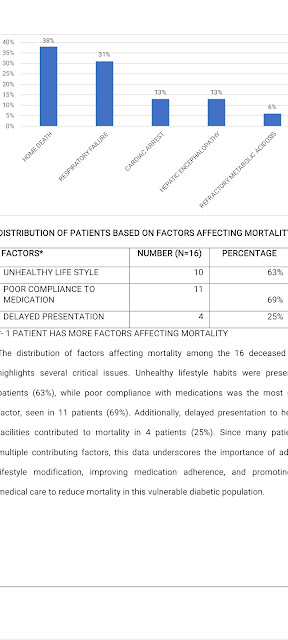Narketpally 2022-25 Diabetes Metabolic Syndrome Clinical Complexity Outcomes Triad, concordance, complications and mortality.
Principal investigator: Dr Govardhini
The three most important words in the outcomes of this study are:
1. Concordance: Poor therapeutic concordance (69%) was a key factor contributing to mortality, emphasizing the need for improved concordance strategies, perhaps through effective CBBLE PaJR systems driven syndromic approaches.
2. Complications: Prevalent complications like CKD (62%) and heart failure underscore the importance of early intervention and management to reduce morbidity and mortality.
3. Mortality: High mortality rate (32%) mainly due to home deaths and respiratory failure, highlighting the severity of diabetes complications.
These three words represent critical aspects of the study's findings, including the importance of therapeutic concordance, the prevalence of complications in diabetic patients and the high mortality rate due to the above two.
Timeline of first patient encounters over the project time period:
Web 2.0 to 3.0 conversational learnings that should have been done manually around every patient soon after admission to produce a richer higher quality prospective study data:
[05/05, 21:50] AI: Given the patient's complex medical history and multiple comorbidities, a comprehensive treatment plan is essential. While it's challenging to recommend a specific regimen without knowing the patient's current goals and preferences, here are some potential considerations:
...(Opinion: irrelevant to the individual's requirements)
These are general suggestions, and the best treatment regimen for this patient would depend on their individual needs, preferences, and medical history.
[06/05, 08:50]cm: AI can only provide good outputs as long as it gets good quality data that highlights the patient's current goals, preferences, context and values.
I guess in the EMR summary data for each patient that we may have been able to extract for this current project that kind of quality data is lacking as that would have necessitate d putting each patient under more meticulous follow up to gain informational continuity to understand how their events , connections and context shaped their current goals and preferences (requirements).
50 diabetes patient EMR summaries and their Web 3.0 AI driven thematic analysis prepared in May 2025
Initial Project plan link prepared in 2022:
Insights from this Narketpally 2022-25 Diabetes Metabolic Syndrome Clinical Complexity Outcomes project in low resource settings:
The Narketpally 2022-25 Diabetes Spectrum Triad reveals key insights into diabetes management and outcomes. This consists of three primary themes:
Theme 1: Demographics and Factors Influencing Outcomes:
- *Age and Gender Distribution*: The majority of patients (18/50) fall within the 60-69 age group, with a slight predominance of males (27/50).
- *Duration of Diabetes*: Most patients have a long-standing history of diabetes, with one patient having had the condition for 30 years.
- *Glycemic Control*: The average HbA1c level is approximately 6.93, with 62% of patients achieving HbA1c ≤ 7.0 post-intervention.
Factors Influencing Outcomes*:
CONCORDANCE Timely intervention, diet compliance, and regular dialysis positively impact outcomes, while delayed presentation, non-compliance, and addictions (alcohol/smoking) negatively affect outcomes.
Theme 2:
COMPLICATIONS and Comorbidities
- *Macrovascular Complications*: Coronary artery disease (CAD) is the most common macrovascular complication, affecting 18/50 patients.
- *Microvascular Complications*: Diabetic foot and gangrene (13/50) and diabetic neuropathy (7/50) are notable microvascular complications.
- *Infections and Other Complications*: 20/50 patients developed infections, and 2/50 experienced diabetic ketoacidosis (DKA).
Theme 3: MORTALITY and Survival Rates*: The mortality rate is 32% (16/50), with sepsis/multi-organ dysfunction syndrome (MODS) being a leading cause of death
- *CKD and Mortality*: 16% (8/50) of patients with CKD succumbed to the disease, highlighting the importance of managing renal complications.
Medical education feedback:
[16/05, 08:49]cm: Thanks! Any explanation for why some months had more patient selection than other months?
[16/05, 09:05]pi: I was posted in nephro in those months sir,mostly i collected mhd cases as they visit frequently for sessions and reliable for followup sir so the graph reached it's peak in that period
[18/05, 20:48]cm: Narketpally 2022-25 Diabetes Metabolic Syndrome Clinical Complexity Outcomes Triad:
concordance, complications and mortality.
Principal investigator: Dr Govardhini
https://medicinedepartment.blogspot.com/2025/05/narketpally-project-2022-25-diabetes.html?m=1
[19/05, 03:16] Metacognitist Mover and Shaker1: Extraordinary!!
[19/05, 12:39]cm: We could engage with the data even though it was just from intern written EMR summaries because it was directly related to our day to day work on trying to optimise clinical complexity. This was again because we ensured that our PGs chose clinical complexity topics that were designed to mandatorily follow up the patient outcomes longitudinally with or without PaJR.
If they had their way and chose for instance a topic where just a single cross sectional data on early diabetics and their LV dysfunction was plotted we couldn't have done much!










No comments:
Post a Comment